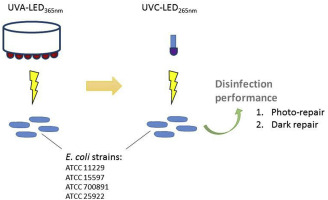Water Research ( IF 11.4 ) Pub Date : 2018-05-15 , DOI: 10.1016/j.watres.2018.05.021 Y. Xiao , X.N. Chu , M. He , X.C. Liu , J.Y. Hu

|
Ultraviolet (UV) light emission diode (LED), which is mercury free and theoretically more energy efficient, has now become an alternative to conventional UV lamps in water disinfection industry. In this research, the disinfection performance of a novel sequential process, UVA365nm LED followed by UVC265nm LED (UVA-UVC), was evaluated. The results revealed that the responses of different bacterial strains to UVA-UVC varied. Coupled with appropriate dosages of UVC, a 20 min UVA pre-radiation provided higher inactivations (log inactivation) of E. coli ATCC 11229, 15597 and 700891 by 1.2, 1.4 and 1.2 times, respectively than the sum of inactivations by UVA alone and UVC alone. On the contrary, the inactivation of E. coli ATCC 25922, the most UVC sensitive strain, decreased from 3 log to 1.8 log after UVA pre-radiation. A 30 min UVA pre-radiation did not affect the photo repair capacity of the four strains (n = 23, p > 0.1), but their dark repair ability was significantly inhibited (n = 14, p < 0.05). Mechanism study was conducted for two representative strains, E. coli ATCC 15597 and 25922 to understand the observed effect. The hypothesis that UVA pre-radiation promoted the yield of reactive oxygen species (ROS) was rejected. ELISA results indicated that 18% more cyclobutane pyrimidine dimers (CPD) were formed in E. coli ATCC 15597 with UVA pre-radiation (n = 3, p < 0.01), however, the CPD levels of E. coli ATCC 25922 was the same with or without UVA pre-radiation (n = 3, p > 0.01). Considering the results of both dark repair and CPD formation, it was concluded that the increased UV sensitivity of E. coli 15597 was originated from the increased CPD. For E. coli ATCC 25922, the enhanced UV resistance was attributed to the strain's adoption of a survival strategy, translesion DNA synthesis (TLS), when triggered by UVA pre-radiation. The study on UmuD protein, which is a key protein during TLS, confirmed this hypothesis.
中文翻译:

UVA预辐射对UVC消毒性能的影响:失活,修复和机理研究
无汞且理论上更节能的紫外线(UV)发光二极管(LED)现在已成为水消毒行业中传统紫外线灯的替代品。在这项研究中,评估了一种新的顺序过程的消毒性能,即365nm UVA LED之后是265nm UVC LED(UVA-UVC)。结果表明,不同细菌菌株对UVA-UVC的反应各不相同。加上适当剂量的UVC,20分钟的UVA预辐射分别使大肠杆菌ATCC 11229、15597和700891的灭活(对数灭活)分别比单独通过UVA和UVC的灭活总和高1.2倍,1.4倍和1.2倍。独自的。相反,大肠杆菌的灭活对UVC最敏感的菌株ATCC 25922,在UVA预辐射后从3 log降低到1.8 log。30分钟的UVA预辐射不会影响这四个菌株的光修复能力(n = 23,p> 0.1),但是它们的暗修复能力却被显着抑制(n = 14,p <0.05)。为研究两种代表性菌株大肠杆菌ATCC 15597和25922进行了机理研究,以了解观察到的效果。否定了UVA预辐射可提高活性氧(ROS)产量的假设。ELISA结果表明,通过UVA预辐射在大肠杆菌ATCC 15597中形成的环丁烷嘧啶二聚体(CPD)多18%(n = 3,p <0.01),但是,大肠杆菌的CPD水平带有或不带有UVA预辐射的ATCC 25922相同(n = 3,p> 0.01)。考虑到黑暗修复和CPD形成的结果,可以得出结论,大肠杆菌15597的UV敏感性增强是由于CPD升高。对于大肠杆菌ATCC 25922,增强的抗紫外线性归因于该菌株在被UVA预辐射触发时采用了生存策略,即病灶DNA合成(TLS)。对TLS过程中的关键蛋白UmuD蛋白的研究证实了这一假设。











































 京公网安备 11010802027423号
京公网安备 11010802027423号